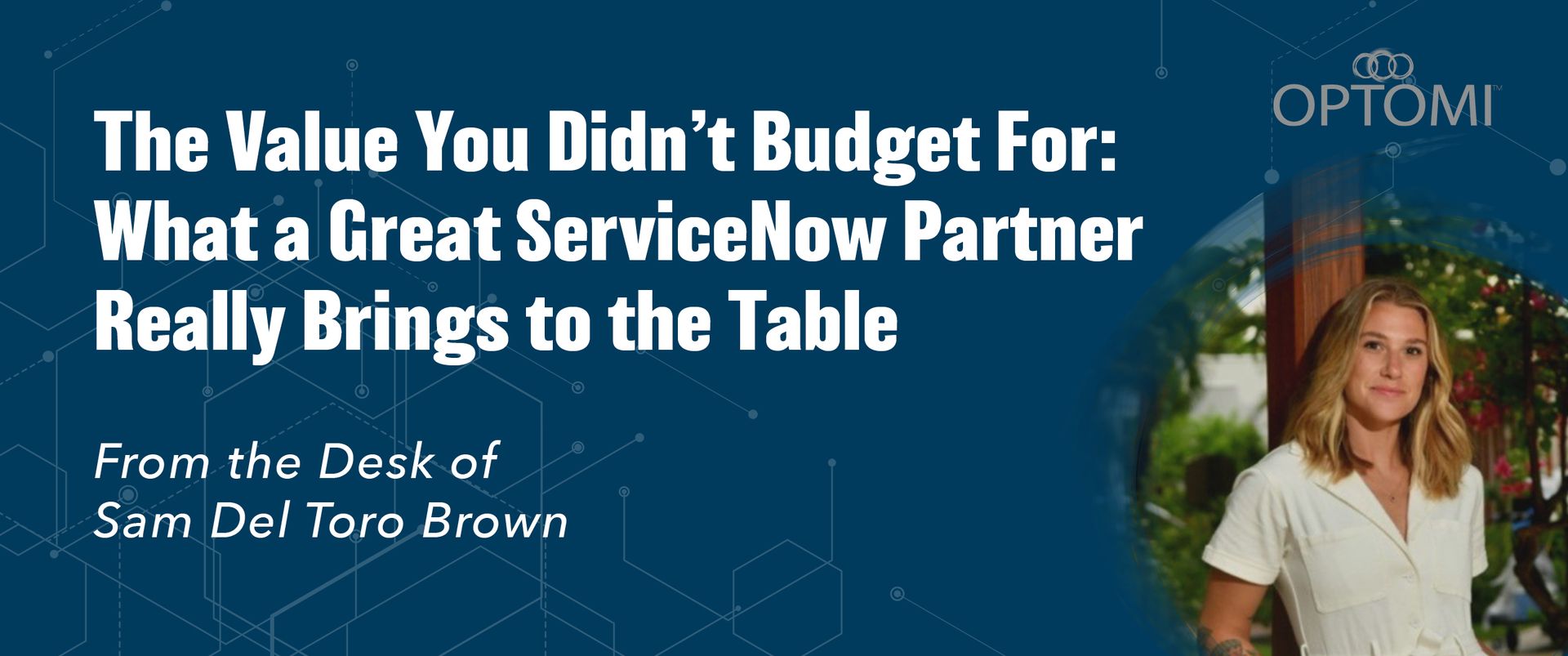
From the desk of Sam Del Toro Brown – Team Lead, ServiceNow Recruiting. Del Toro Brown is a trusted advisor in the ServiceNow ecosystem with a proven track record of placing specialized resources critical to the enablement of platform and client success.
It’s no secret that organizations across the globe are investing heavily in ServiceNow. While the ROI on a well-implemented ServiceNow instance speaks for itself, it’s a hefty price tag to consider when you’re running an initial POC. Organizations must consider licensing amounts, modules they would benefit from, minimum spend, yearly subscription costs, running costs, and implementation costs – all of which are highly variable based on the needs of each organization.
It's a lot to consider. So, what separates a successful ServiceNow rollout from one plagued by years of friction and scope creep? The truth is, there is no single answer…but after hundreds of conversations with leaders actively utilizing ServiceNow, I’ve come to understand that the single most important decision when implementing ServiceNow is the partner you choose. This decision can make or break your experience with the platform.
With implementation success hinging on selecting the right partner, how do you choose from the hundreds of options in the ServiceNow ecosystem? Let’s be real – everyone wants to pay less for more, and that’s exactly where the secret lies. The best ServiceNow partners deliver value that stretches beyond what’s written in the SOW. It’s not always about paying less upfront. The right partner might cost more initially, but save you significantly in the long run. Why? Because great partners don’t just execute, they align with your business goals, prioritize long-term platform health over short-term wins, and set you up for success after they’ve stepped away. And most importantly, they’re not afraid to tell you “No” when it matters.
If you’re evaluating potential partners, these three points are where you need to start in your vendor evaluation:
Deliverables Aren’t the Whole Story: Long-Term Platform Health > Short-Term Wins
The Problem: The most common frustration I hear from organizations post-ServiceNow implementation is this: “They only delivered exactly what was in the requirements. Nothing more, nothing less. There was no consideration for external systems, business processes, inefficiencies, opportunities for automations, future risk, or technical debt.” That might sound like a successful implementation on paper, but in reality, it often signals a lack of strategic thinking. And that’s the problem: if the implementation only reflects what was documented, the outcome is limited by the quality of the initial requirements. Delivered does not equate to being usable. Real success is in adoption, alignment, and relevance to business outcomes.
The Solution: Great partners don’t just deliver, they go beyond task completion. They understand the why behind each requirement and actively collaborate with your stakeholders, ask the right questions, and try to understand how each piece impacts your business.
If your ServiceNow partner isn’t asking:
- Who is this impacting?
- What problem are you looking to solve?
- How does this problem impact the business?
- What dependencies are involved?
- What long-term plans should we consider?
…then they are not building with a future in mind and doing you a disservice.
Remember: It’s easy to deliver what’s asked for; it’s harder, but more valuable, to build what scales. The hidden value lies in a partner who designs with governance, sustainability, and future state in mind.
Post-Go-Live Scaries
The Problem: ServiceNow is officially live in your environment – now what? Your implementation partner did their job, packed up, and moved on. Now you’re wondering:
- How do I find resources with ServiceNow expertise?
- What does ongoing maintenance look like?
- Am I really supposed to upgrade this thing every six months?
- Why can’t I delete an update set?
- How do I get the organization to actually use this?
You’re not alone. These are classic post-go-live scaries, and without the right plan, they can turn into real roadblocks.
The Solution: A great ServiceNow partner doesn’t just implement and disappear. They build time for knowledge transfer, internal team training, and a solid hypercare phase. The best partners take it one step further; they help you identify internal roles and skillsets you need for continuous platform growth. They provide strategic advice on user adoption and change management, ultimately setting you up for success after they’re long gone. A great ServiceNow partner doesn’t just set you up for go-live; they set you up for long-term success. Even after the invoices stop coming.
Remember: There is a life after implementation. Ask yourself: How does your partner strategically work with organizations to ensure long-term success after they’re no longer in the picture?
The Strategic “No” – Why You Want a Partner Who Pushes Back
The Problem: You don’t know what you don’t know. Not every idea should make it into production, and best practices are best practices for a reason. Did you know that over-customization could cost you more to fix than you paid for your initial implementation?
The Solution: The right partner protects you from bad investments, over-customization, and platform debt. It’s the partner’s job to guide you about what you don’t know. You need a partner who:
- Identifies smarter out-of-the-box solutions
- Prevents automation of broken or insufficient workflows
- Steers you away from decisions that could lead to upgrade issues or data loss
Remember: Hearing “No” from a partner isn’t resistance; it is protective and necessary to direct you toward a smarter path and long-term success.
Sam will be joining the
Optomi Professional Services team at
ServiceNow Knowledge25. Learn more about her take on what a great ServiceNow partner really brings to the table at booth #3613 next week (May 6th - 8th, 2025)!











